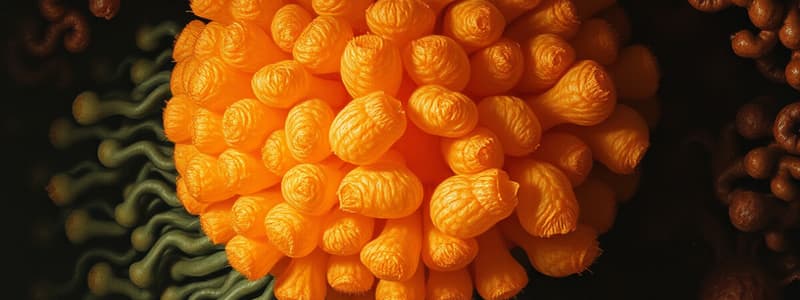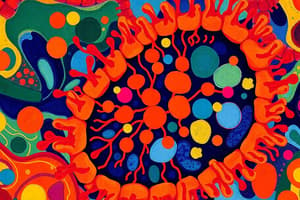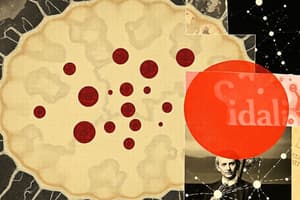Podcast
Questions and Answers
What is the main function of the Golgi apparatus?
What is the main function of the Golgi apparatus?
- Sorting proteins for their final destinations (correct)
- Synthesizing ribosomal RNA
- Producing ATP for cellular respiration
- Decomposing hydrogen peroxide
Which organelle is primarily involved in the detoxification of reactive oxygen species?
Which organelle is primarily involved in the detoxification of reactive oxygen species?
- Lysosomes
- Golgi apparatus
- Peroxisomes (correct)
- Ribosomes
What type of enzymes are packaged by the Golgi apparatus to form lysosomes?
What type of enzymes are packaged by the Golgi apparatus to form lysosomes?
- Oxidases
- Proteins for secretion
- Hydrolytic enzymes (correct)
- Synthetases
What is the role of the ubiquitin proteasome system in cells?
What is the role of the ubiquitin proteasome system in cells?
How do secretory vesicles function in protein export?
How do secretory vesicles function in protein export?
Which of the following is NOT a function of peroxisomes?
Which of the following is NOT a function of peroxisomes?
Which organelle resembles lysosomes but contains different enzymes?
Which organelle resembles lysosomes but contains different enzymes?
What byproduct is generated during the detoxification process in peroxisomes?
What byproduct is generated during the detoxification process in peroxisomes?
What is the primary function of cellular cargos?
What is the primary function of cellular cargos?
Which organelle is involved in organizing the spindle microtubules during cell division?
Which organelle is involved in organizing the spindle microtubules during cell division?
What occurs to the centrosome during cell division?
What occurs to the centrosome during cell division?
What is the role of microtubules in cell division?
What is the role of microtubules in cell division?
Which of the following structures is considered a cellular cargo?
Which of the following structures is considered a cellular cargo?
What is the main function of the microtubule-organizing center?
What is the main function of the microtubule-organizing center?
What are centrioles primarily composed of?
What are centrioles primarily composed of?
How many sets of centrosomes are involved in the division process as indicated?
How many sets of centrosomes are involved in the division process as indicated?
What surrounds the centrioles?
What surrounds the centrioles?
Which of the following best describes the relationship between centrosomes and chromosomes during cell division?
Which of the following best describes the relationship between centrosomes and chromosomes during cell division?
What happens to cellular cargos like organelles during cell division?
What happens to cellular cargos like organelles during cell division?
In what orientation are pairs of microtubules arranged in centrioles?
In what orientation are pairs of microtubules arranged in centrioles?
Which statement about centrosomes is accurate?
Which statement about centrosomes is accurate?
What is the role of the pericentriolar material?
What is the role of the pericentriolar material?
Which structure acts as a microtubule-organizing center?
Which structure acts as a microtubule-organizing center?
What would likely occur if centrosomes failed to duplicate during cell division?
What would likely occur if centrosomes failed to duplicate during cell division?
Which component is essential for the structural formation of the microtubule-organizing center?
Which component is essential for the structural formation of the microtubule-organizing center?
What primarily dictates microtubule organization in a cell?
What primarily dictates microtubule organization in a cell?
What is a characteristic feature of microtubules?
What is a characteristic feature of microtubules?
Which cellular activity is significantly influenced by centrioles?
Which cellular activity is significantly influenced by centrioles?
What is the primary role of transfer RNA (tRNA) in translation?
What is the primary role of transfer RNA (tRNA) in translation?
What structure does ribosomal RNA (rRNA) provide during the translation process?
What structure does ribosomal RNA (rRNA) provide during the translation process?
What is the function of the codons found in messenger RNA (mRNA)?
What is the function of the codons found in messenger RNA (mRNA)?
How many nucleotides are present in each codon of mRNA?
How many nucleotides are present in each codon of mRNA?
Which of the following is NOT a component of the ribosomal structure?
Which of the following is NOT a component of the ribosomal structure?
What defines the end of the polypeptide chain during protein synthesis?
What defines the end of the polypeptide chain during protein synthesis?
What is the shape of the tRNA molecule, and why is it important?
What is the shape of the tRNA molecule, and why is it important?
Which region of tRNA is responsible for carrying the specific amino acid?
Which region of tRNA is responsible for carrying the specific amino acid?
What type of RNA carries the genetic code from the nucleus to the ribosomes?
What type of RNA carries the genetic code from the nucleus to the ribosomes?
Which part of the ribosome is mainly involved in decoding the genetic message from mRNA?
Which part of the ribosome is mainly involved in decoding the genetic message from mRNA?
What initiates the formation of a complete ribosomal complex during translation?
What initiates the formation of a complete ribosomal complex during translation?
During the elongation phase of translation, where does the tRNA carrying the peptide chain move after transferring its amino acid?
During the elongation phase of translation, where does the tRNA carrying the peptide chain move after transferring its amino acid?
What role do release factors play in the translation process?
What role do release factors play in the translation process?
What happens to the tRNA after it has transferred its amino acid to the growing polypeptide chain?
What happens to the tRNA after it has transferred its amino acid to the growing polypeptide chain?
What direction does the ribosomal complex move along the mRNA during translation?
What direction does the ribosomal complex move along the mRNA during translation?
Flashcards are hidden until you start studying
Study Notes
Golgi Apparatus
- Modifications such as glycosylation and proteolytic cleavage occur in the Golgi apparatus.
- Golgi apparatus sorts proteins based on modifications for final destinations inside or outside the cell.
- Golgi vesicles transport proteins; they can form secretory vesicles for export or lysosomes for digestion.
Lysosomes
- Lysosomes are membranous sacs containing hydrolytic enzymes.
- These enzymes are crucial for digestion and waste removal within cells.
Peroxisomes
- Resemble lysosomes but house different enzymes, such as oxidases and catalase.
- Function in detoxification, producing hydrogen peroxide (H₂O₂), which is broken down into water and oxygen.
- Involved in lipid metabolism and the breakdown of long-chain fatty acids.
Proteasomes
- Responsible for degrading endogenous proteins in the cell, requiring ATP.
- They play a critical role in maintaining protein balance and cellular health.
Centrosome and Centrioles
- The centrosome organizes microtubules during cell division, ensuring proper chromosome movement.
- During division, the centrosome duplicates and migrates to opposing cell poles.
Microtubules
- Composed of cylindrical structures arranged in pairs, providing structural support and aiding in intracellular transport.
Translation Process
- Involves decoding mRNA by ribosomes and tRNA, forming peptide bonds among amino acids.
- mRNA carries genetic instructions from the nucleus to ribosomes.
- tRNA acts as an adapter, ferrying amino acids to the ribosome according to mRNA codons.
Ribosomal Structure
- Ribosomes consist of two units: 60S and 40S subunits, facilitating protein synthesis.
- Ribosomal RNA (rRNA) provides structural support for tRNA and mRNA interactions during translation.
tRNA Structure and Function
- tRNA has a unique 3D structure with double-stranded regions and loops, resembling an "L" shape.
- Each tRNA has regions that recognize codons on mRNA and bind specific amino acids.
Translation Steps
- The initiator tRNA binds to the start codon at the P site of the ribosome, forming an initiation complex.
- As elongation progresses, tRNA molecules move through three sites (A, P, E) of the ribosome, facilitating peptide bond formation and amino acid transfer.
- Translation continues until a stop codon is reached, where a release factor signals termination.
Studying That Suits You
Use AI to generate personalized quizzes and flashcards to suit your learning preferences.




